Triggerfish are fascinating creatures found in various oceans worldwide. They captivate aquarists with their vibrant hues and unique appearances. Not only are they visually appealing, but they also provide a tasty treat, providing succulent white meat that can be cooked or eaten raw. However, did you know that triggerfish come in a variety of different sizes? Let’s explore the fascinating world of triggerfish and rank 12 types of triggerfish by size!
1. Stone Triggerfish (Pseudobalistes naufragium) – up to 3.3 Feet
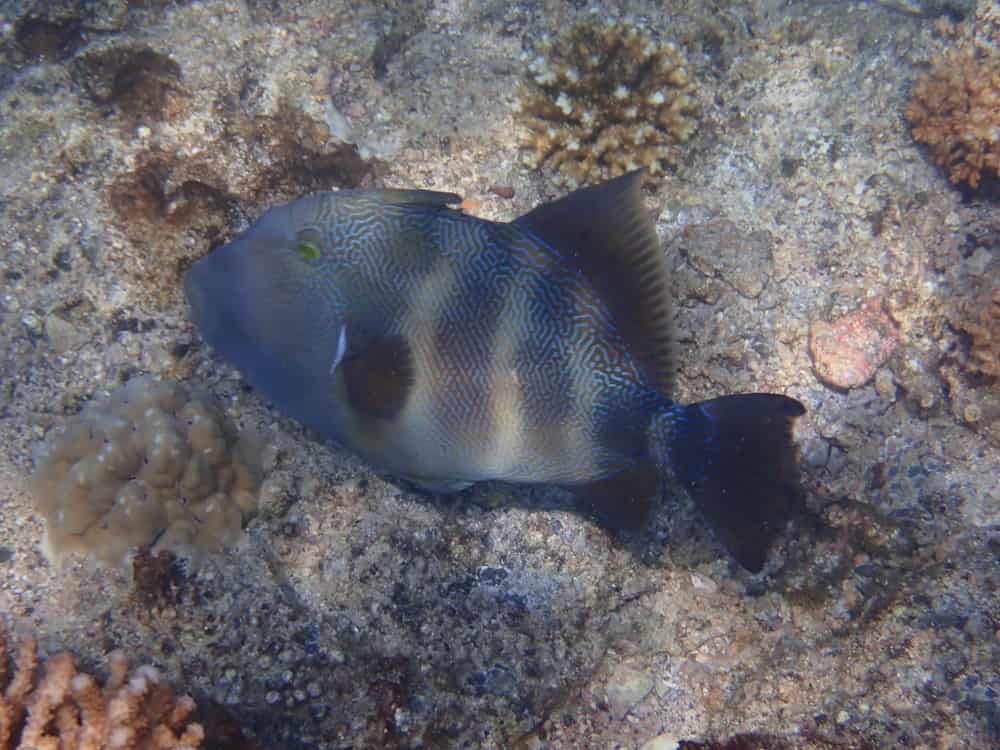
The largest triggerfish in the world is the stone triggerfish.
©iNaturalist Panamá user: keesgroenendijk / CC BY-SA 4.0 – License
The stone triggerfish holds the title of being the largest type of triggerfish. While this type of triggerfish can grow up to a length of 3.3 feet, it is more commonly about half that size.
This fish is covered in scales resembling plates, except for a bare patch of skin located behind its jaws. Like most triggerfish, it has 16 strong teeth, eight in each jaw. Its body has an angular oval shape, with wide dark bands that are often broken and blotchy. Additionally, there is a network of narrow slanting blue lines on its body, which transform into scribbles on its back and tail base. The face of this fish sports blue spots.
In terms of diet, this triggerfish primarily feeds on small crustaceans, mollusks, and sea urchins.
You can find the stone triggerfish in the Eastern Pacific, spanning from Mexico to Chile. It is commonly encountered in relatively shallow coastal areas, particularly around coral reefs.
Unfortunately, there is currently limited information available specifically about the stone triggerfish, which prevents us from delving deeper into its characteristics and behavior.
2. Titan Triggerfish (Balistoides viridescens) – up to 2.5 Feet

Often mistaken as the largest type of triggerfish, the titan triggerfish actually comes in second.
©Vitaliy 6447/Shutterstock.com
The titan triggerfish, often mistaken as the largest triggerfish, actually takes the second spot, reaching a length of 2.5 feet.
This species of triggerfish boasts a head and body covered in sturdy scales. There is a noticeable groove in front of both eyes, and on each side of the tail, you can find around five rows of spines. When it comes to appearance, the titan triggerfish stands out with its distinct coloring. The scales have dark centers, and there is a black region adorned with yellow spots that cover the eyes and extends toward the bases of the pectoral fins. Furthermore, the dorsal and anal fins feature black edges.
In their natural habitat, titan triggerfish live in lagoons and reefs, typically at depths of up to 160 feet, spanning across the Indo-Pacific region. Although they may take a curious bite at divers, their primary diet consists of hard corals, hard-bodied benthic invertebrates, and algae.
These fish can display aggression when defending their nests. In fact, there have even been instances where titan triggerfish attacked three divers. These triggerfish are naturally territorial, with the male diligently guarding its nest.
3. Finescale Triggerfish (Balistes polylepis) – up to 2.5 Feet

With its habitat spanning from San Francisco to Peru, the finescale triggerfish can also be found in the Galapagos Islands.
©Juan A. Malo de Molina / CC BY-SA 4.0 – License
The finescale triggerfish takes the third spot on the list, measuring up to 2.5 feet, just like the titan triggerfish.
These triggerfish are brownish to bluish-gray in color, with the head adorned with blue speckles that can appear more vibrant when they are feeding or engaged in fights. Their body is notably compressed, featuring a large head that ends in a small mouth equipped with powerful, protruding incisor-like teeth.
When it comes to their diet, finescale triggerfish primarily feed during the daytime, targeting various slow-moving benthic invertebrates such as sponges, shrimp, snails, sea urchins, and crabs. Their habitat spans the Pacific Coast of the Americas, ranging from San Francisco down to Peru, including the Galapagos Islands.
Finescale triggerfish tend to inhabit rocky reefs and slopes that border sandy areas. They can be found at depths ranging from the surface down to 1,700 feet.
Finescale triggerfish offer excellent all-white fillets that possess a mild flavor and a dense texture. However, it’s worth noting that their skin is quite tough, resembling leather. To clean them properly, use a sharp fillet knife and possibly a knife sharpener.
4. Gray Triggerfish (Balistes capriscus) – up to 2 Feet

Reaching up to 2 feet in size, the gray triggerfish lives in the Atlantic Ocean.
©Diego Delso / CC BY-SA 4.0 – License
The gray triggerfish, or the leatherjacket, reaches a maximum size of up to 2 feet. These triggerfish re predominantly live in the western Atlantic Ocean, ranging in depths from 80 to 300 feet. Adult gray triggerfish inhabit hard ocean bottoms, reefs, ledges, and artificial reefs.
Gray triggerfish are typically pale grey, greenish-grey, or yellowish-brown in color. Their body features three broad dark stripes, which are not very distinct, as well as a pale streak on their chin. Interestingly, the upper part of their eye is blue.
Adult gray triggerfish primarily consume invertebrates. Their menu includes shrimps, sea urchins, and crabs.
In 2021, commercial landings of gray triggerfish amounted to 208,000 pounds, with a total value of approximately $626,000. It’s worth noting that wild-caught gray triggerfish from the United States is an excellent seafood choice, as it is harvested and managed sustainably responsibly under U.S. regulations.
5. Starry Triggerfish (Abalistes stellaris) – up to 2 Feet

Measuring up to 2 feet long, the starry triggerfish is also known as the flat-tailed triggerfish.
©Izuzuki / CC BY-SA 3.0 – License
The starry triggerfish, also known as the flat-tailed triggerfish, is a tropical and harmless species that resides at the bottom of the ocean. It reaches a maximum size of 2 feet.
This type of triggerfish has a light grey body with yellow spots. It features four white patches below its dorsal fin, with the last patch located near the base of its tail. Interestingly, the starry triggerfish is quite curious and has a tendency to observe divers from a distance.
The habitat of the starry triggerfish spans the Indo-West Pacific region, extending from the Red Sea to East Africa. It can be found in areas with mud, silty sand bottoms, as well as coral reefs.
For a balanced diet, the starry triggerfish requires a variety of meaty foods, including mussels, shrimp, squid, small fish, krill, and shellfish.
6. Bluespotted Triggerfish (Balistes punctatus) – up to 2 Feet
The bluespotted triggerfish secures the sixth position on the list, boasting a maximum size of 2 feet. It is a beautiful fish, exhibiting a light yellowish body adorned with dark spots and vibrant blue markings. Notably, each side of its body features a striking gold-colored spot.
This type of triggerfish is native to the eastern Atlantic Ocean, ranging from Morocco to the Canary Islands. The bluespotted triggerfish lives in coastal waters, specifically over sand and rock bottoms. The bluespotted triggerfish sustains itself by feeding on bivalves and crabs, among other things.
Considered the diligent workers of the reef, these triggerfish are often busy engaging in activities such as turning over rocks, stirring up the sand, and nibbling on pieces of branching coral.
When it comes to aquarium keeping, it’s important to note that the bluespotted triggerfish don’t typically coexist well with other species within the same family. If other specimens are present in the tank, it is advisable to provide a large aquarium to minimize aggressive and hostile behavior.
This species is naturally aggressive, but it also possesses a curious nature and a tendency to explore its surroundings.
7. Yellowmargin Triggerfish (Pseudobalistes flavimarginatus) – up to 2 Feet
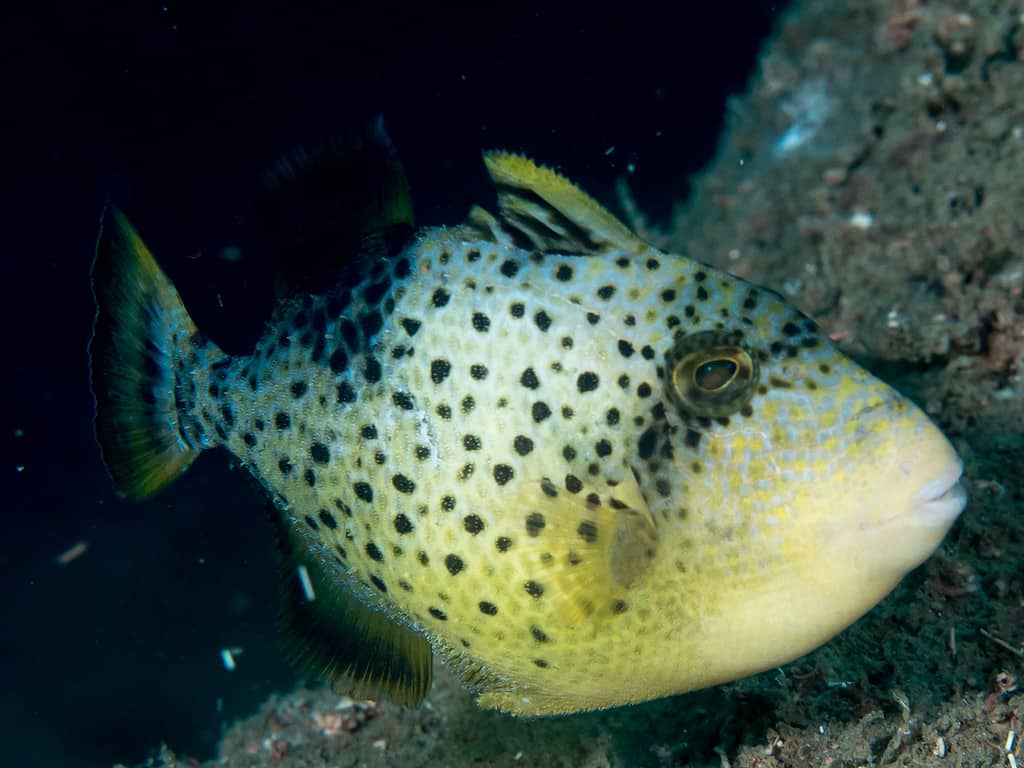
This type of triggerfish has bulbous eyes.
©Rickard Zerpe / CC BY 2.0 – License
The yellowmargin triggerfish is the seventh type of triggerfish on this list, measuring up to 2 feet long.
This triggerfish displays a distinct pattern as an adult, with diamond-shaped whitish-yellow markings adorning its body. The facial area and lower body showcase a yellowish hue, while the main body appears yellowish-brown. Black spots scatter across its body, with a higher concentration around the eye. The yellowmargin triggerfish’s eye is bulbous in shape, encircled by a yellow ring with brown marks on it.
The yellowmargin triggerfish lives in the coral reefs and coastal waters of the tropical Indo-west and Central Pacific regions. It primarily feeds on various marine creatures, including tunicates, crabs, sea urchins, and smaller fish.
When females are guarding their eggs, they may exhibit slight aggression towards divers, although not to the extent of the titan triggerfish.
Although yellowmargin triggerfish are visually appealing, they are not commonly kept in aquariums due to their size and territorial behavior.
8. Queen Triggerfish (Balistes vetula) – up to 2 Feet
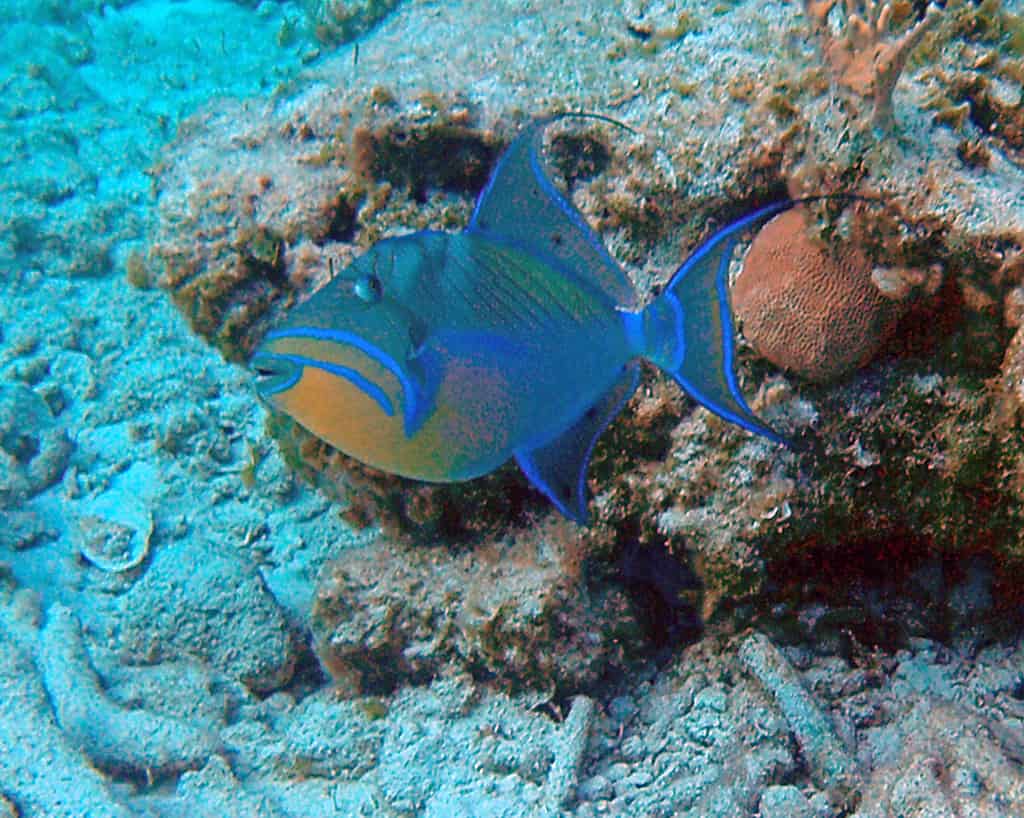
Aggressive during breeding season, the queen triggerfish lives in the Atlantic Ocean.
©James St. John / CC BY 2.0 – License
The queen triggerfish, also known as the old wife, is a reef-dwelling triggerfish predominantly found in the Atlantic Ocean. They can reach a size of 2 feet, making it one of the biggest triggerfish!
Along its back, you’ll find a blend of gray and greenish-blue shades. The lower portion of its head and abdomen boasts a striking orange-yellow hue. What truly catches the eye are the two distinct curved bands in bright blue, gracefully stretching from the snout and extending below and in front of the pectoral fins.
Feeding primarily on benthic invertebrates, the queen triggerfish has a particular appetite for sea urchins. This type of triggerfish employs a unique hunting technique by creating water currents that overturn the urchins, exposing their vulnerable undersides where the spines are shorter, thus making them susceptible to predation.
These vibrant and oval-shaped fish are highly sought after as attractions in aquariums. While the queen triggerfish is occasionally caught for food, it is important to exercise caution during the breeding season. This is because they become fiercely defensive of their territory and can deliver a powerful bite.
9. Clown Triggerfish (Balistoides conspicillum) – up to 1.6 Feet

The striking coloration of the clown triggerfish gives it its name.
©Halawi/Shutterstock.com
The clown triggerfish secures the ninth position on the list, reaching a maximum length of 1.6 feet.
Known for its striking coloration and unique personality, this reef fish truly stands out. It boasts a pattern of fierce black markings adorned with bright white circles on the lower half of its body. Additionally, it has a leopard-like yellow pattern around its dorsal fin and a vibrant yellow mouth.
The clown triggerfish lives across the Indo-Pacific region, spanning from the coast of East Africa in the Indian Ocean to the shores of the Central Pacific. However, despite its wide distribution, this colorful species is less common on reefs than other types of triggerfish.
Clown triggerfish utilize their sharp teeth to prey on a variety of marine creatures, such as crabs, mollusks, urchins, other crustaceans, and sea squirts.
Among the 40 known species of triggerfish, the clown triggerfish is the only one that is unsafe for consumption. This is because larger and older specimens are prone to bacteria and parasites. As a result, it is advisable to avoid consuming clown triggerfish weighing over five pounds.
10. Redtoothed Triggerfish (Odonus niger) – up to 1.6 Feet

Deep purple in color, the redtoothed triggerfish is planktivorous.
©Rickard Zerp / CC BY 2.0 – License
The redtoothed triggerfish is another large triggerfish, reaching a maximum length of 1.6 feet. It is commonly found in the tropical Indo-Pacific region.
Redtoothed triggerfish are typically deep purple in color, with blue-green markings on the head. Their fins and tail lobes have striking light blue margins. Their tail is distinctly lyre-shaped, and their skin is thick and reminiscent of leather, featuring non-overlapping scales.
These triggerfish are primarily planktivorous, meaning they primarily feed on zooplankton carried by ocean currents. Furthermore, they have the ability to form schools while feeding. Sponges also form another part of their diet.
Redtoothed triggerfish are one of the more peaceful species within the triggerfish family. However, as they age, they can become more threatening and may even produce a grunting-type sound.
Interestingly, they can change their color, which can vary depending on their mood, food availability, feeding behavior, and water quality.
11. Rough Triggerfish (Canthidermis maculata) – up to 1.6 Feet
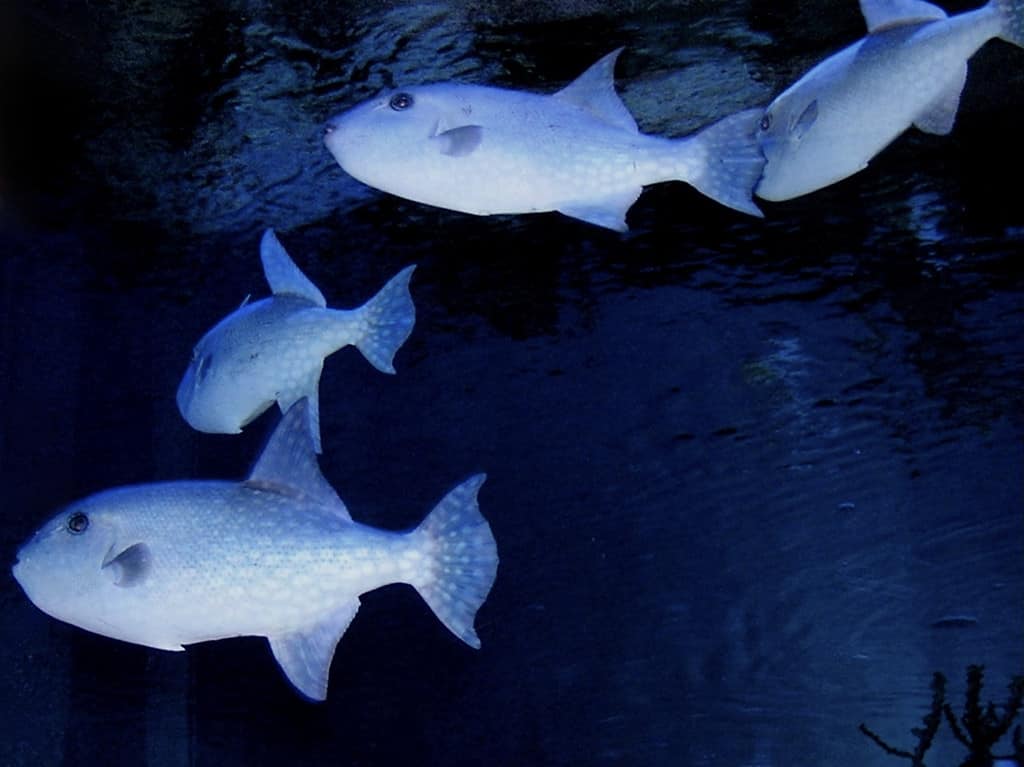
Blueish-gray in color, rough triggerfish can grow up to 1.6 feet.
©NasserHalaweh / CC BY-SA 4.0 – License
The rough triggerfish, native to tropical and subtropical oceans worldwide, earns the eleventh spot on the list, reaching a size of up to 1.6 feet.
Adult rough triggerfish have a blue-grayish coloration, while juveniles appear grayish-black with fading white spots as they age. During mating, adults may have dark blotches on their faces and pectoral fins. These markings are appear on females as they hover above their nests. However, once they ascend in the water column, away from their nests, these dark markings may vanish within a few seconds.
Their diet primarily consists of pelagic zooplankton, crustaceans, and pelagic fish larvae.
Rough triggerfish are generally nonaggressive, shy, and easily startled when confronted by larger fish, such as the titan triggerfish, or when encountered by divers.
12. Black Triggerfish (Melichthys niger) – up to 1.5 Feet
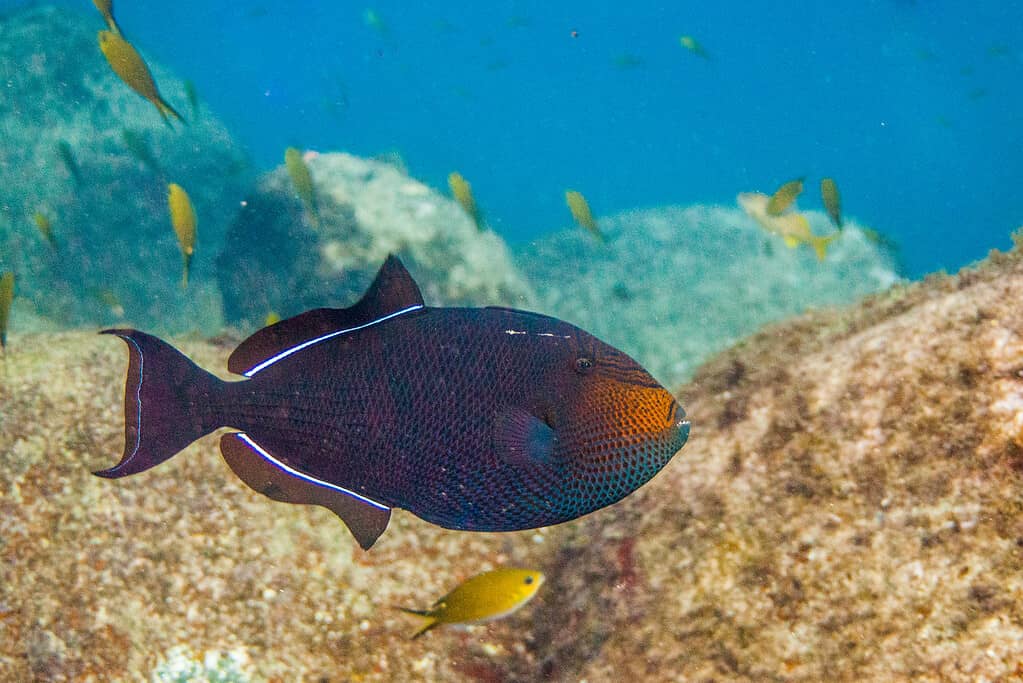
One of the least aggressive triggerfish, the black triggerfish is more dark blue or blue-green than black in color.
©João D’Andretta / CC BY 4.0 – License
The black triggerfish secures the last position on the list, growing up to a size of 1.5 feet. Notably, it is considered one of the least aggressive types of triggerfish.
At first glance, this fish appears black, but under good or bright lighting conditions, it reveals its true color as dark blue or blue-green. It is characterized by bold and noticeable white stripes or lines on its anal and dorsal fins.
The black triggerfish can be found in various habitats, including open waters, exposed coral reefs, and shallows, as well as shores and islands. It is known for its circum-tropical distribution, meaning it can be observed in oceans around the world that share the same tropical latitude.
These triggerfish are omnivorous, consuming squid, small fish, shrimp, algae, zooplankton, and other marine plant life.
Black triggerfish are typically solitary or found in small groups, except on Ascension Islands, where they exist in large numbers. The reason behind this phenomenon is still unknown.
Summary of Triggerfish Ranked by Size
| Rank | Triggerfish | Maximum Size |
|---|---|---|
| 1 | Stone Triggerfish | 3.3 feet |
| 2 | Titan Triggerfish | 2.5 feet |
| 3 | Finescale Triggerfish | 2.5 feet |
| 4 | Gray Triggerfish | 2 feet |
| 5 | Staryy Triggerfish | 2 feet |
| 6 | Bluespotted Triggerfish | 2 feet |
| 7 | Yellowmargin Triggerfish | 2 feet |
| 8 | Queen Triggerfish | 2 feet |
| 9 | Clown Triggerfish | 1.6 feet |
| 10 | Redtoothed Triggerfish | 1.6 feet |
| 11 | Rough Triggerfish | 1.6 feet |
| 12 | Black Triggerfish | 1.5 feet |
The photo featured at the top of this post is © Vitaliy 6447/Shutterstock.com
Thank you for reading! Have some feedback for us? Contact the AZ Animals editorial team.







